October is National Disability Employment Awareness Month and yet 70 percent of people with disabilities nationwide are out of the workforce.
The rates of employment vary widely by state. This report provides details on those states that are leading the country on employing people with disabilities. This report shows that people with disabilities are twice as likely to be working in the Dakotas, Alaska and Wyoming than they are in many other states.
The states with the consistently lowest workforce participation rates are West Virginia, Mississippi, Kentucky, Alabama and Arizona. When taking into consideration the gap between the employment rate of people with disabilities and those without disabilities, Maine and Vermont are added to the list, with Maine coming in dead last in the country.
Unfortunately, many states have continued to fund failed programs and old ways of thinking but there is good news.
According to U.S. Census Bureau statistics from 2013, the following 10 states are leading the nation in creating more job opportunities for the one-in-five Americans who have a disability:
- North Dakota: 52 percent of the state’s 34,800 working-age people with disabilities are employed.
- Wyoming: 50 percent of Wyoming’s 34,000 working-age people with disabilities are employed.
- South Dakota: 48 percent of the state’s 47,700 working-age people with disabilities are employed.
- Alaska: 47 percent of Alaska’s 47,000 working-age people with disabilities are employed
- Minnesota: 46 percent of Minnesota’s 266,400 working-age people with disabilities are employed.
- Nebraska: 45.5 percent of Nebraska’s 88,700 working-age people with disabilities are employed.
- Iowa: 44.8 percent of Iowa’s 169,300 working-age people with disabilities are employed.
- Utah: 42.5 percent of Utah’s 135,100 working-age people with disabilities are employed.
- Colorado: 42.3 percent of Colorado’s 260,700 working-age people with disabilities are employed.
- New Hampshire: 41 percent of New Hampshire’s 77,800 working-age people with disabilities are employed.
The practices discussed in the report can provide a valuable guide to where states have succeeded in in putting best practices into place and where governors have committed to maximizing opportunities for people with disabilities. However, it should be noted that the statistics cited above predate the many new and innovative practices implemented as a result of the National Governors Association and Delaware Gov. Jack Markell’s Better Bottom Line Initiative released in 2013.
It’s important for all states to look at places where leadership, proven practices, and cost-effective policies are getting more people with disabilities into the workforce. As Jennifer Sheehy, Acting Assistant Secretary of the Office of Disability Employment Policy (ODEP), noted, “It is also very important to look at this data as it predates the Workforce Innovation and Opportunity Act which now requires governors in each state to create a plan that will enable people with disabilities to get jobs and develop careers.”
“Given that literally billions of dollars in federal tax dollars will follow those new plans,” she continued, “governors and those such as ODEP that are working with states to improve disability employment, can build on these past successes to create a workforce system that serves everyone well, including employers and people with disabilities.”
ODEP, an agency of the Department of Labor, is a critical resource and influential player in terms of promoting best practices for disability employment.
RespectAbility reached out to several experts to gather their opinions on what accounts for the variations between states. Some experts emphasize that the states with the best disability employment numbers tend to also be states with lower population density, meaning that employers need every available worker. The demand for workers certainly impacts some states, but the rising tide does not always lift all ships. By looking at the gap between workforce participation rates between people with and without disabilities, you quickly see that the small population states of Maine and Vermont are vastly outperformed by other states.
“Maximizing the dollars available for Vocational Rehabilitation (VR) services is sorely needed and will make a big difference,” said Stephen Wooderson, CEO of the Council of State Administrators of Vocational Rehabilitation. “But job seekers with disabilities are faced with a whole host of other distractors and obstacles that must be addressed as well.”
“That doesn’t relieve VR of striving to always improve, but it does mean that the challenge in disability employment policy and practice has to be comprehensive to include disincentives to employment and an assessment of how services funded (or not funded) through state and federal sources focus on the impact on the job seeker with a disability. Beyond the public policy and funding challenges, each state has specific environmental and economic matters that impact the employability of all job seekers.”
Dr. Andrew J. Houtenville, Associate Professor of Economics and Research Director, Institute on Disability at the University of New Hampshire, created an extremely helpful spreadsheet, which is included below. He rightly points out that South Carolina has shown significantly more improvement in employment for people with disabilities than even for people without them.
It is worth a deeper dive into some of the states that were succeeding even before the NGA’s Better Bottom Line initiative:
1) North Dakota
North Dakota has the coveted distinction of being the state with the highest rate of employment for individuals with disabilities, employing 52.8 percent of their citizens with disabilities. North Dakota is part of the Promoting the Readiness of Minors in Supplemental Security Income (PROMISE) Grant, a collaborative effort that promotes career achievement as a means of gaining economic self-sufficiency and a diminished dependence on public benefits among youth who receive Social Security Insurance (SSI). The PROMISE Grant enables states to develop curricula and projects that will improve education for youth with disabilities, thereby equipping these youth with the tools to succeed in the workforce.
Vocational Rehabilitation has long played a critical role in empowering people with disabilities to pursue the transformative power of a job. In 2012, North Dakota’s Division of Vocational Rehabilitation obtained employment for 708 people out of an applicant pool of 1,521. While direct service is critically important, VR is doing much more to ensure that the people of North Dakota see the talent in each individual and are willing to give people of ALL abilities a chance to succeed. Recently, the Division launched a website called ND Advantage, which provides employers information about the financial incentives for hiring vocational rehabilitation referrals such as the Work Opportunity Tax Credits. Another benefit that ND Advantage highlights is Disability Access Credit, which provides expenses to companies who employ individuals with disabilities to cover such services as sign language interpreters and assistive technology. Gov. Jack Dalrymple’s leadership has led to a more prosperous state and opened the American Dream to many people with disabilities.
2) Wyoming
Wyoming has the second highest percentage of employed people of disabilities (50.7 percent), compared with 79 percent of people without disabilities. Still, with all this good news we expect for things to get even better in Wyoming as the Wyoming Employment First Task Force, which was created last year, now fosters even more collaboration between the public and private sectors to craft solutions for employing people with disabilities. Wyoming also has benefitted from the MentorAbility program, which emulates the strategies used by Project SEARCH. Strong leadership through an earlier Business Leadership Network also brought best practices and enthusiasm to the state. Today fully 2,400 youth with disabilities, between the ages of 16 and 20, are preparing to enter the workforce in Wyoming. However, Wyoming returned $858,951 dollars to Washington — money that was meant to help people with disabilities find employment. With the new workforce law, Gov. Matt Mead now has the chance to ensure that Wyoming sustains it success and creates even more jobs. Because Wyoming has citizens who care deeply about the success that inclusive hiring can bring employers, it could rise to the top slot in the future.
3) South Dakota
The employment rate for people with disabilities in South Dakota is 48 percent compared to 83 percent of people without disabilities. South Dakota became a model state for disability employment in part because Gov. Dennis Daugaard has a personal interest in the subject as a son of two deaf parents. As a member of the NGA, Gov. Daugaard supported Gov. Markell’s Better Bottom Line Initiative and he helped organize hearings on finding employment solutions for people with disabilities. Furthermore, South Dakota created the Employment Works Task Force, which develops hiring solutions for people with disabilities.
In addition, South Dakota’s Department of Human Services recently launched its new Ability for Hire program, which alters public perceptions and touts the benefits of hiring individuals with disabilities. Ability for Hire’s approach to achieving this ambitious goal is through networking, educating, and informing supervisors, businesses, and the general public about what individuals with disabilities have to offer.
Project SEARCH, immerses interns into a structured environment, combines education with career exploration, and has proven been one of the nation’s most effective programs in transitioning young people with disabilities into the workforce. South Dakota has been very active in establishing Project SEARCH sites throughout the state at diverse locations such as Avera Health Care Systems and South Dakota State University. To quote Gov. Daugaard, “Project SEARCH is a perfect example of how businesses can work together with state and local governments to make a real difference….this program gives young South Dakotans with disabilities the tools they need to succeed as they enter adulthood.”
South Dakota should serve as a model for other states on how implementing strategies that provide employment opportunities for people with disabilities can produce successful results.
4) Alaska
In Alaska roughly half of individuals with disabilities between the ages of 18-64 are employed (47.8 percent) compared to 75.2 percent of people without disabilities. The employment rate for people with disabilities is up nearly 9 percent from 2012.
Recent state efforts have played a significant role in narrowing the employment gap between people with disabilities and those without disabilities. In order to encourage entrepreneurship among low-income individuals with disabilities, Alaska has established an Industry-Driven Support model that provides trainings on a variety of business topics, networking sessions, and one-on-one business support to entrepreneurs. In addition, Alaska has created the State as a Model Employer Task Force, targeting recruitment of individuals with disabilities, and identifying best practices for accommodations and workplace inclusion.
Like South Dakota, Alaska has had great success through school to work transition programs for youth with disabilities. Project SEARCH has had tremendous success collaborating with the Anchorage school district, Providence Alaska Medical Center, Mat-Su Borough School and the Mat-Su Regional District.
Alaska’s success proves that a multifaceted approach improves employment outcomes for people with disabilities. Alaska has put into action a variety of cost effect best practices and proven models. RespectAbility’s Disability Employment First Planning Tool contains such practices and has many other ideas to follow. Under Gov. Bill Walker, Alaska appears to be headed in a positive direction, and is looking forward to a bright future of continued progress in ensuring that people with disabilities receiving greater opportunities to thrive in the workforce.
5) Minnesota
In Minnesota, the employment rate of people with disabilities is 46 percent compared to 83 percent of people without disabilities. By 2018, Gov. Mark Dayton has a goal that 7 percent of the state workforce will be people with disabilities.This effort also requires state hiring managers to undergo training for recruiting people with disabilities. By showing that people with disabilities are successful employees in state government, Minnesota is breaking down stigmas around hiring. Likewise, the Minnesota Department of Employment and Economic Development have extensive resources available that emphasize the business case for hiring people with disabilities. Beyond just making resources available, the Department is also making critical investments in programs providing employment services such as on-the-job training and job placements.
When people with disabilities get the skills they need to successfully transition into the workforce, employers gain access to a talent pool of individuals whose diverse abilities can contribute to their bottom line. Like Wyoming, Minnesota has benefited from leadership shown through the Minnesota Business Leadership Network. Peer-to-peer relationships between companies underscore the business imperative for hiring people with disabilities. In Minnesota, 3M and Northwest Airlines are models of best practices and worth emulation.
6) Nebraska
45.5 percent of Nebraskans with disabilities are employed, compared to 82.6 percent of Nebraskans without disabilities. Nebraska has invested in a Ticket to Work website, assisting jobseekers with disabilities to network with employers seeking to hire these individuals, and professionals serving both groups. In addition, Nebraska remains an active participant in Project Search, a nationwide initiative to employ individuals with disabilities, boasting programs with 14 different host organizations. Furthermore, Nebraska has distinguished itself by becoming one of the states to pass a state level ABLE Act, which enables individuals with disabilities to save money while maintaining federal benefits and other forms of necessary assistance. The White House recognized David Scott from Embassy Suites Omaha-La Vista as a 2014 White House Champion of Change for his work on a Project SEARCH Program enabling young people with disabilities to transition in careers in the hospitality field. Gov. Pete Ricketts has much reason to be proud of his state and to continue the fight for more jobs for all Nebraskans.
7) Iowa
In Iowa, 44 percent of people with disabilities are employed. After initially returning $2,314,114 to the federal government after failing to spend the money on state Vocational Rehabilitation programs, leaders such as Gov. Terry Branstad and Vocational Rehabilitation Director David Mitchell ensured that the resources were properly utilized. Recently, groups such as the Iowa Vocational Rehabilitation Services (IDVR) and the Iowa Developmental Disabilities Council, in partnership with other organizations, have come together to establish the Iowa Coalition for Integrated Employment. The program transitions people with disabilities into a competitive workforce. The state also is streamlining its paper work to enable Iowans with a variety of barriers to employment and employers to be better served while saving money for taxpayers. Private sector employers including Kwik Trip, Unity Point Hospital, Bankers Trust and Mercy Hospital have set up successful partnerships with Iowa Vocational Rehabilitation Services.
Beyond partnerships and maximizing returns on investments, Iowa also shows that people with disabilities – including people with significant intellectual disabilities – can be wonderful contributors to the workforce, communities and families alike. The entrepreneurship and enterprise of Emilea Hillman, a young woman with developmental differences who is now a coffee shop owner in Independence, Iowa shows what people with disabilities can contribute to the workforce.
8) Utah
Utah continues to narrow the gap between the 42.5 percent of residents with disabilities who are employed and 76.6 percent of residents without disabilities. Utah employs a series of supports provided to both jobseekers with disabilities and potential employers through the Choose to Work Utah and Work Ability Utah programs, as well as their Employment First Priority Initiative. These programs go beyond job placement services to provide on-the-job training and employment support services, as well as work incentives and benefits planning for people with disabilities transitioning off of government benefit programs like SSI or SSDI. Utah also provides more than 11 financial incentives to employers to hire people with disabilities, including the Welfare to Work Tax Credit and Work Opportunity Tax Credit. At the same time, >Utah’s Employment First Priority initiative, signed into law by Gov. Gary Herbert in 2011, provides individuals with significant disabilities integrated employment at competitive wages.
9) Colorado
Colorado’s employment rate of people with disabilities is up two percentage points from the previous year to 42.3 percent, compared to 77.3 percent of people without disabilities. Gov. Hickenlooper signed an Achieving a Better Life Experience (ABLE) Act into law which allows families to that have cash savings over $2,000 and still be eligible for Medicaid and other government benefits programs, allow beneficiaries to go back to work without quickly losing benefits. Furthermore, Colorado has created Ability Connection Colorado, an exceptional resource in supporting individuals with disabilities in their pursuit of employment.
10) New Hampshire
In New Hampshire, 41.8 percent of people with disabilities are employed compared to the 80.3 percent of people without disabilities. This includes 1,087 job placements by vocational rehabilitation. As a parent of a child with disabilities, Gov. Maggie Hassan has made it a priority to address the employment needs of people with disabilities. As she said upon signing a ban on sub-minimum wage work, including more people with disabilities “into the heart and soul of our democracy, our communities, our economy, has a great ripple effect, not only for individuals and not only for their families, but for our economy, too.”
State to Watch – South Carolina
While it may not yet rank in the top 10, one state that deserves closer attention is South Carolina. Not only has there been a 1.3 percent increase in the employment rate of people without disabilities, there has also been a 2.7 percent increase in employment among South Carolinians with disabilities. Just recently, Gov. Nikki Haley talked about the importance of employing people with disabilities.
Haley praised Walgreens’ distribution center in Anderson for their efforts at integrating employees with disabilities. She went so far as to call Walgreens “a source of pride.” However, there’s more work to be done in order to open more opportunities for the 340,300 working age people with disabilities living in South Carolina.
Closing Thoughts – The new workforce law, hope, and history.
In looking at the states and the data, Mathmatica’s leading expert on employment of people with disabilities David Stapleton, notes, “The increase in the employment rate for people with disabilities relative to that last year is the most substantial increase we have seen since the late 1980s.”
However, there is more work that needs to be in order to empower more people with disabilities to pursue the American Dream. Under the new Workforce Innovation and Opportunity Act, governors across the country have a chance to build a better future for all Americans with barriers to work. Under this law, it is possible to enable more people with barriers by breaking down the siloes between education, transportation, workforce development, healthcare and other departments. Enabling people with disabilities to work is win-win-win for them, employers and taxpayers alike.
Stephen Wooderson of CSAVR echoed this sentiment.
“The challenge for us in the public vocational rehabilitation profession at the state level is to work toward providing high quality services by maximizing the resources for the VR program, collaboration with business and allied organizations and having uniquely qualified vocational rehabilitation counselors.”
In looking to empower more people with disabilities, it is important for states to look at what works, what does not, and what will be most cost-effective. The good news is that there are proven programs and effective models worth investing in as a part of WIOA. RespectAbility has partnered with several other disability organizations to create a toolkit on best practices for states as they implement the new workforce law. RespectAbility also offers free webinars talking about the intersection of disability issues and the workforce system. Above all else, this toolkit should be a starting point for states that are looking to copy what worked in the top 10 states and to capitalize on the talents that people with disabilities bring with them into the workforce.
Table 1 Ranking 50 States by Employment Rates and Employment Gap
Data Source- Column 1: Table 2.1: Employment—Civilians with Disabilities Ages 18 to 64 Years Living
in the Community for the United States and States: 2013 from the Annual Disability Statistics
Compendium
Data Source-Column 2: Table 2.9: Employment Gap—Civilians Ages 18 to 64 Years Living in the
Community for the United States and States, by Disability Status: 2013 from the Annual Disability
Statistics Compendium
Link: http://disabilitycompendium.org/compendium-statistics/employment
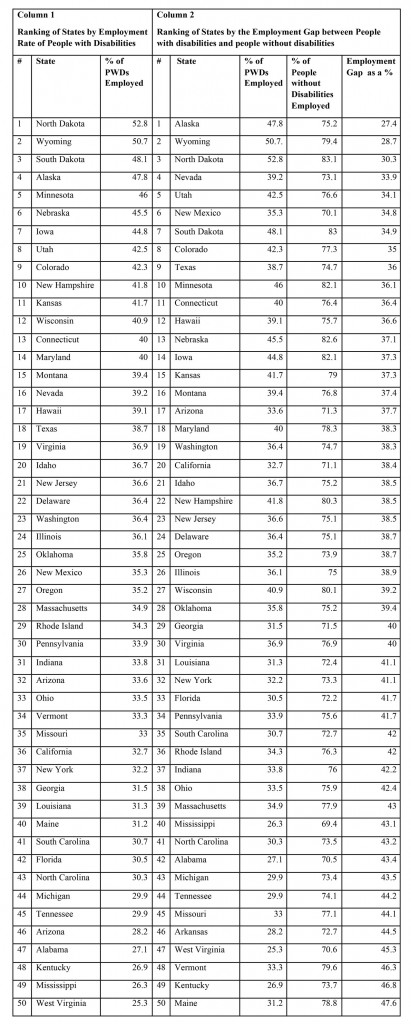
Table 2
From 2012 to 2013, the employment gap closed by one percentage point or more in 22 states.
The top four states with the greatest reductions (AK, RI, WY, and NH) were small states– with
working-age populations under one million persons. It is hard to make comments about small
states, because these statistics are estimates based on state-level samples. Smaller states have
smaller samples and thus have a higher degree of year-to-year variability. I am hesitant to read
too much into reductions and expansions in the employment gap for small states.
Looking at large states– with working-age populations over 5 million persons–Illinois (a 2.3
percentage point reduction) and New Jersey (a 1 percentage point reduction) stand out. These are two large industrial states.
All of the states that experienced reductions greater that one percentage point also
experienced increases in employment rate of people with disabilities, so none of these
reductions were due a reduction in the employment rate of people without disabilities.
The state that really stands out is South Carolina, with a 2.3 point reduction, while also
having a 1.3 point increase in the employment rate of people without disabilities. The big
question is whether we can attribute success, like the success in South Carolina to changes
in policy or new innovative approaches to employing people with disabilities.
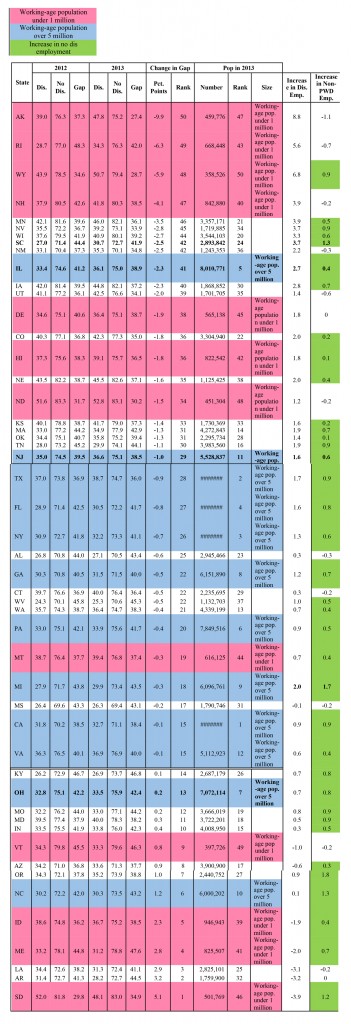
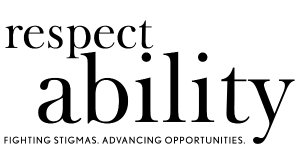



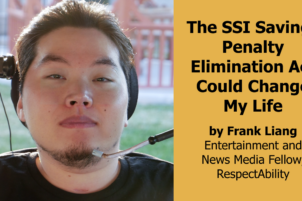



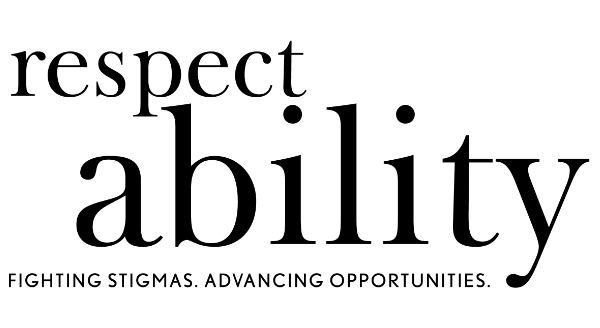
Comments on this entry are closed.